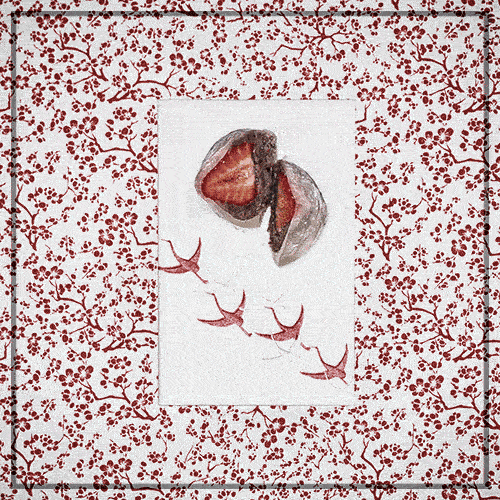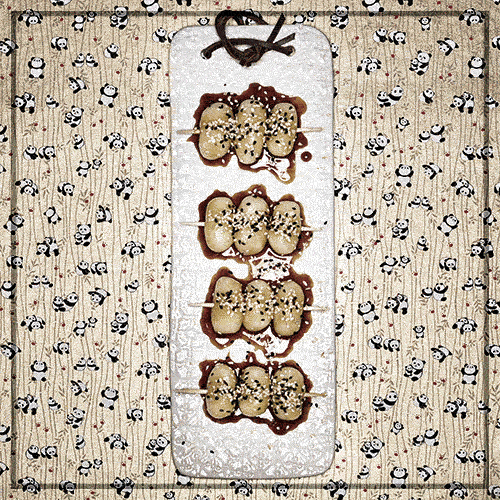MOCHIS - Part 1
....
Photos: Chiara Cigliutti
Recipes: Pio
Article: Thordis Rüggeberg
..
Fotos: Chiara Cigliutti
Rezepte: Pio
Text: Thordis Rüggeberg
....
....
"With astonishment and trembling," writes the court protocol, one has to approach the Japanese emperor. Well, I won’t probably find myself in that position, ever.
Japan is very high on my travel wishlist, even though it’s not that long ago since - measured in half-life period - a nuclear power plant exploded.
Somehow, another Asian country has always managed to jump in the queue.
Nowadays though Greta is raising her CO2 index finger admonishingly, therefore I'm on vacation on the folding sofa at my relatives in Cologne-Nippes. You have to make sacrifices in order to save the world. Nevertheless, the yearning remains.
While Aunt Hilde is getting her hair done (by the neighbor, at home) I stroll through the neighborhood. Somewhere between the traditional pubs "Em Golde Kappes" and "Fünkchen's Bürgerstüffge" (we will talk another time about the matter with Germans and the apostrophes), I discover an Asian shop and I instantly know what to do against my Wanderlust. I will turn Aunt Hilde's kitchen into a Far Eastern oasis. Today, the Danube Waves (ie. it’s a german pastry) are on vacation - today we have mochi, Japanese candy made from sticky rice.
"Well, that’s so exciting!"
Aunt Hilde gets the big ladder from the basement to balance the microwave out of the kitchen cupboard.
"Werner won this at the company party in 1992, but why should I use it?"
The microwave roars and flickers like Fukushima just before the meltdown. I am amazed and trembling even without the presence of an emperor, Aunt Hilde is enthusiastic: “Who would have thought that that thing still works?!"
The dough is down right glassy and soon small filled balls shine like exotic chocolates on the Hutschenreuther Zwiebelmuster.
Uncle Werner dares to come in - in his red kimono: Rose Monday 1984.
Aunt Hilde digs the paper umbrellas from the ice cream cups out of the drawer ("Look, how good I kept them!"), and since we have no chopsticks, we turn two spoons over and eat with the stems.
Uncle Werner washes down the mochi with plenty of kölsch - just to be safe. After all, there have already been deaths from suffocation while eating mochis. He read it on the internet earlier today. And since I have one of these modern phones, I should play Roy Black’s song "In Japan, the sun rises."
The lantern light chain above the sink flashes and changes colors, Aunt Hilde has rosy cheeks from this whole exotic, Uncle Werner is on his fourth beer. And since everything is so exciting, it reminds her of her honeymoon on Lake Garda in 1963. They talk and laugh loud and wild and confused, it's almost as incomprehensible as Japanese.
For my train trip back home the next day Aunt Hilde has prepared some food supplies, with which I could easily feed the entire staff of an intercontinental flight. On top of it sticks a paper umbrella.
"I'll leave the microwave downstairs," she says. "When do you have holidays next time? You’ll stay longer right!? "
She hugs me hard, her blouse and women's jeans with elastic waistband transform for a moment in a flowered apron.
It feels good to save the world.
..
„Mit Staunen und Zittern“, so schreibt das Hofprotokoll vor, habe man sich dem japanischen Kaiser zu nähern. In die Verlegenheit werde ich wohl vorerst nicht kommen.
Japan steht auf meiner Reisewunschliste sehr weit oben, und das, obwohl es noch gar nicht lange her ist - in Halbwertszeit gemessen – seit da ein Atomkraftwerk explodierte.
Irgendwie hat sich bisher immer ein anderes asiatisches Land vorgedrängelt. Jetzt hebt Greta mahnend den CO-Zweigefinger, also mache ich Urlaub auf dem Klappsofa bei der Verwandtschaft in Köln-Nippes. Man muss Opfer bringen, um die Welt zu retten. Dennoch: die Sehnsucht bleibt.
Tante Hilde werden die Haare gelegt (von der Nachbarin, zuhause), ich schlendere durchs Viertel. Als ich irgendwo zwischen den Traditions-Kneipen „Em Golde Kappes“ und „Fünkchen´s Bürgerstüffge“ (über die Sache mit den Deutschen und dem Apostroph unterhalten wir uns mal an andere Stelle) einen Asia-Laden entdecke, weiß ich, was gegen das Fernweh zu tun ist. Ich werde Tante Hildes Küche in eine fernöstliche Oase verwandeln. Heute haben die Donauwellen frei – es gibt Mochi, japanische Süßigkeiten aus Klebreis.
„Nä, wat aufregend!“
Tante Hilde holt die große Leiter aus dem Keller, um die Mikrowelle vom Küchenschrank zu wuchten.
„Die hat der Werner 1992 beim Betriebsfest gewonnen, aber wat soll ich denn damit?“
Die Mikrowelle dröhnt und flackert wie Fukushima kurz vor der Kernschmelze. Ich staune und zittere auch ohne die Anwesenheit eines Kaisers, Tante Hilde ist begeistert: „Ich hätt nich jedacht, dat dat Ding et noch tut.“
Der Teig wird astrein glasig, bald liegen die kleinen gefüllten Bällchen wie exotische Pralinen auf Hutschenreuther Zwiebelmuster.
Jetzt traut sich auch Onkel Werner herein – im roten Kimono: Rosenmontag 1984.
Tante Hilde kramt die Papierschirmchen von den Eisbechern aus der Schublade („siehste, gut dass ich die aufbewahrt habe!“), und weil wir keine Stäbchen haben, drehen wir zwei Löffel um und essen mit den Stielen.
Onkel Werner spült die Mochi mit reichlich Kölsch herunter - sicherheitshalber, schließlich sei es beim Mochi-Essen schon zu Todesfällen durch Ersticken gekommen. Hat er vorhin im Internet gelesen. Und ich hätte doch dieses moderne Telefon, ich soll da jetzt mal das Lied von dem Roy Black abspielen, „In Japan geht die Sonne auf“.
Die Lampion-Lichterkette über der Spüle blinkt und wechselt die Farben, Tante Hilde hat rosafarbene Wangen von der ganzen Exotik, Onkel Werner ist beim vierten Bier. Und weil alles so aufregend ist, erinnert sie das an ihre Flitterwochen am Gardasee, 1963, und sie reden und lachen laut und wild und durcheinander, es ist fast so unverständlich wie Japanisch.
Für die Zugrückfahrt am nächsten Tag hat mir Tante Hilde ein Fresspaket vorbereitet, mit dem ich locker die Gesamtbelegschaft eines Interkontinentalflugs versorgen könnte. Obenauf klebt ein Papierschirmchen.
„Ich lass die Mikrowelle mal unten stehen“, sagt sie. „Wann hasse denn dat nächste mal Urlaub? Dann bleibse aber wat länger!“
Sie drückt mich kräftig an sich, ihre Bluse und die Damenjeans mit Elastikbund verwandeln sich für einen Moment in eine geblümte Kittelschürze.
Es fühlt sich gut an, die Welt zu retten.
(P. S.: Ich war noch nie in Nippes, und ich spreche auch kein Kölsch. Habt ihr schon gemerkt, nicht wahr?)
....
....
Mix the flour, sugar, vanilla and coconut milk and cook in three to four steps of 90 seconds in the microwave at 800 watts, stirring each time with a dampened spatula stir (color of the dough should change from white to glassy).
Then put the dough on baking paper (already sprinkled with plenty of cornstarch) and let it cool slightly. With the help of more cornstarch, make small balls out of the dough, cut the dough into squares and pull down from all sides and stick together. Then moisten, roll in coconut and serve immediately!
INFO: The use of "Shiratamako" (flour from soaked glutinous rice) results in a very smooth, finer and more elastic texture or alternatively take "Mochigomeko" or "Mochiko" (flour from washed glutinous rice): this results in a less elastic, doughier texture!
..
Mehl, Zucker, Vanille sowie Kokosmilch verrühren und in drei bis vier Schritten à 90 Sekunden abgedeckt in der Mikrowelle bei 800 Watt garen, dabei nach jeder Erwärmung mit einem angefeuchteten Spatel umrühren (Farbe des Teigs sollte von weiß auf glasig wechseln).
Anschließend Teig auf Backpapier geben, welches mit reichlich Stärkemehl bestreut ist und etwas abkühlen. Später aus dem Teig unter Zuhilfenahme von weiterem Stärkemehl kleine Kugeln formen, dabei den Teig in Quadrate schneiden und von allen Seiten nach unten ziehen und dort verkleben. Anschließend anfeuchten, in Kokos wälzen und sofort servieren!
INFO: Die Verwendung von „Shiratamako“ (Mehl aus eingeweichtem Klebreis), ergibt eine sehr glatte, feinere und elastische Textur oder ersatzweise „Mochigomeko“ oder „Mochiko“ (Mehl aus gewaschenem Klebreis) nehmen: dies ergibt eine weniger elastische, teigigere Textur!
....
....
"Mochi" - here with coconut flavor
150 g of glutinous rice flour, INFO see below
50 g of sugar
1 pinch of vanilla powder (= ground vanilla pods)
200 ml coconut milk (classic with water)
Cornstarch, as needed
about 40 g coconut flakes
..
“Mochi” – hier mit Kokosaroma
150 g Klebreismehl, INFO siehe unten
50 g Zucker
1 Messerspitze Vanillepulver (= gemahlene Vanilleschoten)
200 ml Kokosmilch (klassisch mit Wasser)
Stärkemehl, nach Bedarf
ca. 40 g Kokosflocken
....
....
Mix flour, sugar and orange juice and cook in three to four steps of 90 seconds in the microwave at 800 watts, stirring each time with a dampened spatula stir (color of the dough should change from orange-white to glassy).
Then put dough on a baking paper, (already sprinkled with plenty of cornstarch) and let it cool. Roll out 5 mm thin with the aid of further cornstarch, then cut out circles about 8 cm in size, cover each with 20 g of bean paste and cover. Do not grind cashews with turmeric too finely, then moisten the mochi and roll in the nut mixture. Serve immediately!
TIP: Recipe for Anko
INGREDIENTS:
150 g of dried azuki beans
225 g of sugar
The day before soak beans in plenty of cold water.
The following day, drain the beans, then cook with five times the amount of cold water in a saucepan over low heat. Drain and add beans back to the pot, then gradually add sugar and stir at medium heat with constant stirring to a shiny mass - Then puree the bean mixture and let it cool down, covering it directly with cling film.
..
Mehl, Zucker sowie Orangensaft verrühren und in drei bis vier Schritten à 90 Sekunden abgedeckt in der Mikrowelle bei 800 Watt garen, dabei nach jeder Erwärmung mit einem angefeuchteten Spatel umrühren (Farbe des Teigs sollte von orange-weiß auf glasig wechseln).
Anschließend Teig auf Backpapier geben, welches mit reichlich Stärkemehl bestreut ist und abkühlen. Später unter Zuhilfenahme von weiterem Stärkemehl 5 mm dünn ausrollen, dann ca. 8 cm große Kreise ausstechen, mit jeweils 20 g Bohnenpaste belegen und einschlagen. Cashewkerne mit Kurkuma nicht zu fein mahlen, dann Mochi anfeuchten und in Nussmischung wälzen. Sofort servieren!
TIPP: Rezept für Anko
150 g getrocknete Azuki-Bohnen
225 g Zucker
Am Vortag Bohnen in reichlich kaltem Wasser einweichen.
Am Folgetag Bohnen abtropfen, dann mit der fünffachen Menge an kaltem Wasser in einem Topf bei kleiner Hitze weichkochen. Anschließend abgießen und Bohnen zurück in den Topf geben, dann nach und nach Zucker dazugeben und bei mittlerer Hitze unter ständigem Rühren zu einer glänzenden Masse verarbeiten – Für die richtige Konsistenz der Masse sollte diese nach einem Rührvorgang 3 Sekunden den Stand halten. Anschließend Bohnenmischung fein pürieren und abkühlen, dabei direkt mit Klarsichtfolie abdecken.
....
....
"Mame Daifuku" - the Mochi classic: filled with red bean paste, here with orange flavor in cashew turmeric coat
100 g of gluten rice flour
40 g of sugar
150 ml orange juice (classic with water!)
Cornstarch, as needed
about 150 g "Anko" (sweet, red bean paste), home-made or to buy in Asian shops or on the Internet, recipe for homemade Anko see below
60 g of roasted cashews
½ tsp turmeric
..
„Mame Daifuku“ – der Mochi-Klassiker: gefüllt mit roter Bohnenpaste, hier mit Orangenaroma im Cashew-Kurkuma-Mantel
100 g Klebreismehl
40 g Zucker
150 ml Orangensaft (klassisch mit Wasser!)
Stärkemehl, nach Bedarf
ca. 150 g „Anko“ (süße, rote Bohnenpaste), selbst gemacht oder in asiatischen Geschäften oder im Internet zu kaufen, Rezept für selbstgemachtes Anko siehe unten
60 g geröstete Cashewkerne
½ TL Kurkuma
....
....
Mix the flour, sugar and almond milk and cook in three to four steps of 90 seconds covered in a microwave oven at 800 watts, stirring each time with a dampened spatula (the color of the dough should have changed from white to glassy).
Meanwhile, clean strawberries, wash as needed and dry very carefully. Cover each strawberry with a little bean paste and let the top of the strawberry look out!
Put the lukewarm dough on baking paper, (already sprinkled with plenty of cornstarch) and let it cool. Roll out 5 mm thin with the aid of more cornstarch, cut out 10 mm circles and cover each with a strawberry ball.
Serve immediately!
..
Mehl, Zucker sowie Mandelmilch verrühren und in drei bis vier Schritten à 90 Sekunden abgedeckt in der Mikrowelle bei 800 Watt garen, dabei nach jeder Erwärmung mit einem angefeuchteten Spatel umrühren (Farbe des Teigs sollte von weiß auf glasig gewechselt haben).
Inzwischen Erdbeeren putzen, nach Bedarf waschen und sehr sorgfältig trocknen. Jede Erdbeere mit etwas Bohnenpaste umhüllen, dabei die Spitze der Erdbeere herausschauen lassen!
Lauwarm abgekühlter Teig auf Backpapier geben, welches mit reichlich Stärkemehl bestreut ist und abkühlen. Später unter Zuhilfenahme von weiterem Stärkemehl 5 mm dünn ausrollen, dann 10 mm große Kreise ausstechen und jeweils einen Erdbeerball umhüllen.
Sofort servieren!
....
....
"Ichigo Daifuku" - Mochi, filled with strawberry, here flavored with almond milk
100 g of glutinous rice flour, preferably "Shiratamako"
70 g of sugar
155 ml almond milk, (classic with water!)
8 smaller strawberries
160g Anko (sweet, red bean paste), home-made or to buy in Asian stores or on the Internet
Cornstarch, as needed
..
„Ichigo Daifuku“ – Mochi, gefüllt mit Erdbeere, hier aromatisiert mit Mandelmilch
100 g Klebreismehl, vorzugsweise „Shiratamako“
70 g Zucker
155 ml Mandelmilch, (klassisch mit Wasser!)
8 kleinere Erdbeeren
160 g Anko (süße, rote Bohnenpaste), selbst gemacht oder in asiatischen Geschäften oder im Internet zu kaufen
Stärkemehl, nach Bedarf
....








